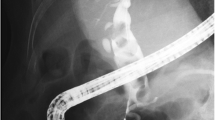Abstract
Background
Endoscopic papillary large balloon dilation (EPLBD) is safe and effective in management of common bile duct stones (CBDS). Endoscopic sphincterotomy (EST) prior to EPLBD has been performed as a standard procedure. However, the significance of EST prior to EPLBD has not been well studied yet.
Aims
To compare the clinical outcomes of EPLBD with and without EST to evaluate the significance of EST.
Methods
Between April 2010 and March 2015, a total of 82 patients with naïve papillae underwent EPLBD with or without EST for the management of CBDS. A retrospective analysis compared the efficacy and safety of EPLBD with and without EST.
Results
Basic patient characteristics were not significantly different between the groups that underwent EPLBD with EST (n = 27) and without EST (n = 55). Complete stone removal rates were similar between the groups (100 % in the EST group and 98 % in the non-EST group, p = 1.00). There was no significant difference in the median balloon size (13 mm in both groups, p = 0.445), rate of application of mechanical lithotripsy (26 vs. 35 % in the EST and non-EST groups, respectively, p = 0.463), or the median procedure time (38 vs. 34 min in the EST and non-EST groups, respectively, p = 0.682). The overall adverse event rates were not statistically different (4 vs. 7 % in the EST and non-EST groups, respectively, p = 1.00). Pancreatitis, cholangitis, and hemorrhage rates were also similar in both groups.
Conclusions
EST prior to EPLBD may be unnecessary since this study did not demonstrate its benefits.


Similar content being viewed by others
References
Kawai K, Akasaka Y, Murakami K, et al. Endoscopic sphincterotomy of the ampulla of Vater. Gastrointest Endosc. 1974;20:148–151.
Classen M, Demling L. Endoscopic sphincterotomy of the papilla of vater and extraction of stones from the choledochal duct (author’s transl). Dtsch Med Wochenschr. 1974;99:496–497.
Staritz M, Ewe K, Meyer zum Buschenfelde KH. Endoscopic papillary dilation (EPD) for the treatment of common bile duct stones and papillary stenosis. Endoscopy. 1983;15:197–198.
Yasuda I, Tomita E, Enya M, et al. Can endoscopic papillary balloon dilation really preserve sphincter of Oddi function? Gut. 2001;49:686–691.
Baron TH, Harewood GC. Endoscopic balloon dilation of the biliary sphincter compared to endoscopic biliary sphincterotomy for removal of common bile duct stones during ERCP: a metaanalysis of randomized, controlled trials. Am J Gastroenterol. 2004;99:1455–1460.
Yasuda I, Fujita N, Maguchi H, et al. Long-term outcomes after endoscopic sphincterotomy versus endoscopic papillary balloon dilation for bile duct stones. Gastrointest Endosc. 2010;72:1185–1191.
Ersoz G, Tekesin O, Ozutemiz AO, et al. Biliary sphincterotomy plus dilation with a large balloon for bile duct stones that are difficult to extract. Gastrointest Endosc. 2003;57:156–159.
Maydeo A, Bhandari S. Balloon sphincteroplasty for removing difficult bile duct stones. Endoscopy. 2007;39:958–961.
Minami A, Hirose S, Nomoto T, et al. Small sphincterotomy combined with papillary dilation with large balloon permits retrieval of large stones without mechanical lithotripsy. World J Gastroenterol. 2007;13:2179–2182.
Itoi T, Itokawa F, Sofuni A, et al. Endoscopic sphincterotomy combined with large balloon dilation can reduce the procedure time and fluoroscopy time for removal of large bile duct stones. Am J Gastroenterol. 2009;104:560–565.
Kim TH, Oh HJ, Lee JY, et al. Can a small endoscopic sphincterotomy plus a large-balloon dilation reduce the use of mechanical lithotripsy in patients with large bile duct stones? Surg Endosc. 2011;25:3330–3337.
Jeong S, Ki SH, Lee DH, et al. Endoscopic large-balloon sphincteroplasty without preceding sphincterotomy for the removal of large bile duct stones: a preliminary study. Gastrointest Endosc. 2009;70:915–922.
Chan HH, Lai KH, Lin CK, et al. Endoscopic papillary large balloon dilation alone without sphincterotomy for the treatment of large common bile duct stones. BMC Gastroenterol. 2011;11:69.
Kogure H, Tsujino T, Isayama H, et al. Short- and long-term outcomes of endoscopic papillary large balloon dilation with or without sphincterotomy for removal of large bile duct stones. Scand J Gastroenterol. 2014;49:121–128.
Cotton PB, Eisen GM, Aabakken L, et al. A lexicon for endoscopic adverse events: report of an ASGE workshop. Gastrointest Endosc. 2010;71:446–454.
Heo JH, Kang DH, Jung HJ, et al. Endoscopic sphincterotomy plus large-balloon dilation versus endoscopic sphincterotomy for removal of bile-duct stones. Gastrointest Endosc 2007;66:720–6; quiz 768, 771.
Kim HG, Cheon YK, Cho YD, et al. Small sphincterotomy combined with endoscopic papillary large balloon dilation versus sphincterotomy. World J Gastroenterol. 2009;15:4298–4304.
Stefanidis G, Viazis N, Pleskow D, et al. Large balloon dilation versus mechanical lithotripsy for the management of large bile duct stones: a prospective randomized study. Am J Gastroenterol. 2011;106:278–285.
Teoh AY, Cheung FK, Hu B, et al. Randomized trial of endoscopic sphincterotomy with balloon dilation versus endoscopic sphincterotomy alone for removal of bile duct stones. Gastroenterology. 2013;144:341–345.
Hwang JC, Kim JH, Lim SG, et al. Endoscopic large-balloon dilation alone versus endoscopic sphincterotomy plus large-balloon dilation for the treatment of large bile duct stones. BMC Gastroenterol. 2013;13:15.
Park SJ, Kim JH, Hwang JC, et al. Factors predictive of adverse events following endoscopic papillary large balloon dilation: results from a multicenter series. Dig Dis Sci. 2013;58:1100–1109.
Author information
Authors and Affiliations
Corresponding author
Ethics declarations
Conflicts of interest
Drs. Mitsuru Okuno, Takuji Iwashita, Kensaku Yoshida, Akinori Maruta, Shinya Uemura, Masanori Nakashima, Tsuyoshi Mukai, Nobuhiro Ando, Keisuke Iwata, Yohei Horibe, Seiji Adachi, Masatoshi Mabuchi, Shinpei Doi, Ichiro Yasuda, and Masahito Shimizu have no conflicts of interest of financial ties to disclose.
Rights and permissions
About this article
Cite this article
Okuno, M., Iwashita, T., Yoshida, K. et al. Significance of Endoscopic Sphincterotomy Preceding Endoscopic Papillary Large Balloon Dilation in the Management of Bile Duct Stones. Dig Dis Sci 61, 597–602 (2016). https://doi.org/10.1007/s10620-015-3891-6
Received:
Accepted:
Published:
Issue Date:
DOI: https://doi.org/10.1007/s10620-015-3891-6




